Another successful guerrilla garden! Earth Day 2009
by Peter Morehead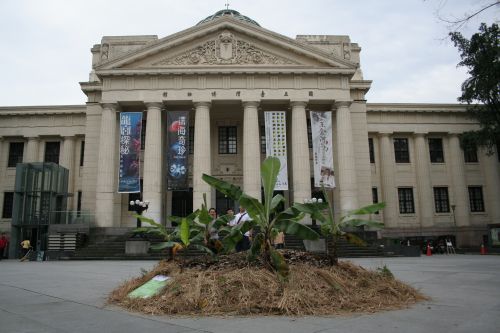
On Buy Nothing Day 2008, students from Taiwan’s first Permaculture Design Course planted a guerrilla garden in the 228 Peace Park in downtown Taipei. Like many successful ecosystems and guerrilla gardens, we benefitted from the edge effect: in this case, the edge of two bureaucratic invisible structures where precious urban space is kept in disuse. The neglected piece of land we chose is right next to the Taiwan National Museum, which is located within the park. The park headquarters thought the land belonged to the museum, while the museum thought the land belonged to the park. As a result, this four-by-three meters square piece of land had been kept non-vegetated for years…until we came along last November.
More than twenty of us spent about an hour forking the  compacted soil loose, picking out rubble, adding compost, applying mulch, and planting food: hongfongtsai, sweet potato, a banana, two papayas, a coffee tree and others. Like other guerrilla gardens, we left only hoping that people would understand our intent. The garden shines at passersby, offering a different perspective on how a park is supposed to look and function. It’s located a few meters in front of the museum and a meter behind a sign with a long list of park rules, including “no gardening.” Much to our happiness and surprise, the garden was well received by the museum staff and everyday hundreds of people stopped to look at it.
compacted soil loose, picking out rubble, adding compost, applying mulch, and planting food: hongfongtsai, sweet potato, a banana, two papayas, a coffee tree and others. Like other guerrilla gardens, we left only hoping that people would understand our intent. The garden shines at passersby, offering a different perspective on how a park is supposed to look and function. It’s located a few meters in front of the museum and a meter behind a sign with a long list of park rules, including “no gardening.” Much to our happiness and surprise, the garden was well received by the museum staff and everyday hundreds of people stopped to look at it.
Eventually the museum’s environmental education director, Xiang Lirong, contacted Earth Passengers, the organizer of the Buy Nothing Day guerrilla garden event, to help hold related events in front of the museum for Earth Day 2009. Our theme focused on how city parks and urban space could be used to create/harvest local resources including energy, water, soil and food. We cut a hole in a downspout of the museum roof and placed a barrel there to collect rainwater. We set up ten pallets to create a 3-bin compost system and within two weeks filled one bin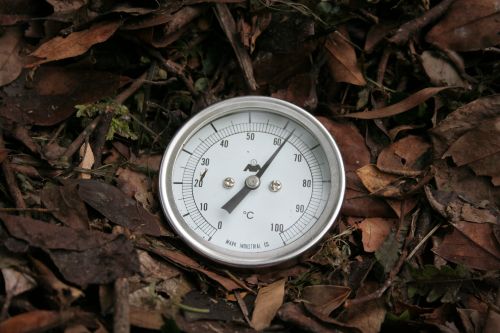 (one cubic meter) with urban organic waste, which promptly heated up to over 60C!
(one cubic meter) with urban organic waste, which promptly heated up to over 60C!
Over the 3 months we had to prepare for the Earth Day event (April 19), we planted more food in the garden: three sisters guild (corn, squash, beans) and sunflowers. This seems to work well with the hongfongtsai, a shade-loving perennial leaf vegetable, growing almost underneath the squash. Once the squash dies in late summer, the hongfongtsai will be ready to take over for the winter, when this garden is completely engulfed in the shade of the museum. We also let many edible and useful weeds grow in the garden to provide cover for beneficial insects. When Earth Day finally came around, we had an excellent demo garden that sparked many conversations.
Although the event was organized by Earth Passengers, it couldn’t have happened so successfully without the participation of many of the 2008 PDC graduates. Some of the permaculture displays and activities included:
Displays and demos:
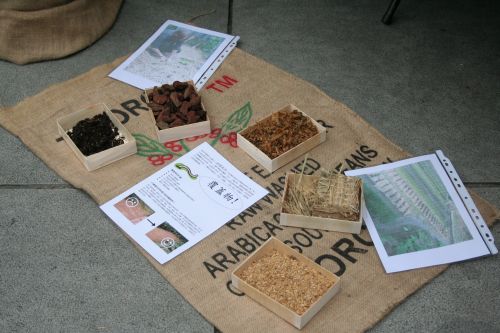
* Rainwater harvesting
* Food garden in the park
* 3-bin composting system for community parks
* Solar cooking
* Rocket stoves
* Banana circle
* Sheet mulching
* The importance of mulch
* Seedball making

 Activities:
Activities:
* Site tours
* Rooftop garden tour by Wild at Heart
* Songs on worms and bikes by Laurie
* Improvisational dance by Youzi
* Auction of the banana circle and compost bins
* Local bands 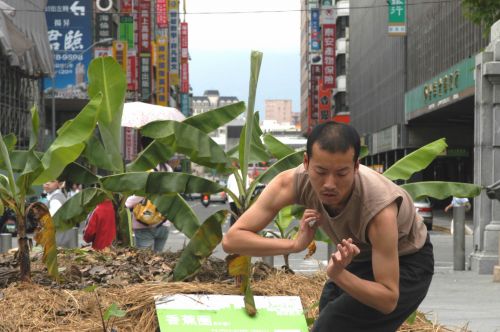
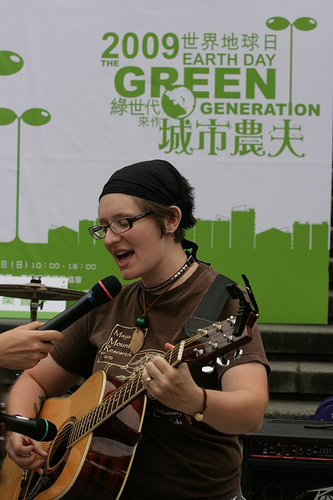

Earth Passengers created and handed out a pamphlet that illustrates how permaculture design principles can be used to help cities make the transition to a low-energy future. In fact, the design of this event was geared toward energy education. Bringing food production nearer to the cities is an important step in energy efficiency. Local recycling of fallen leaves and other organic waste is equally important as it eliminates unnecessary transport and creates humus where it can be used to grow food. Harvesting rainwater and using water-conserving mulch gardening methods cuts down on the 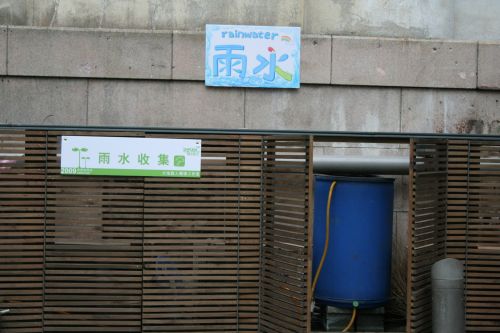 amount of tap water we use, all of which is pumped and treated and piped to our faucets, consuming a great deal of energy per liter. The banana circle offers a way for city parks to not only provide free food but also recycle typhoon debris rather than carting it away for incineration. Solar cooking and rocket stoves provide ways to use local energy efficiently. The energy-theme was further reinforced at the “Energy Story” tent featuring a puzzle on the flow of energy in nature. People were encouraged to get their neighborhood parks to incorporate some of these ideas and begin providing space for food production.
amount of tap water we use, all of which is pumped and treated and piped to our faucets, consuming a great deal of energy per liter. The banana circle offers a way for city parks to not only provide free food but also recycle typhoon debris rather than carting it away for incineration. Solar cooking and rocket stoves provide ways to use local energy efficiently. The energy-theme was further reinforced at the “Energy Story” tent featuring a puzzle on the flow of energy in nature. People were encouraged to get their neighborhood parks to incorporate some of these ideas and begin providing space for food production.
We passed out free vegetable seedlings to get people interested in taking action in their own 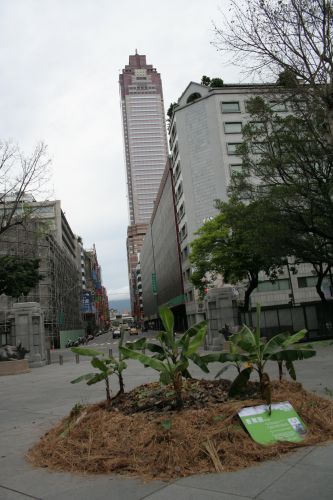 lives. For even if you don’t know how to grow food, oftentimes holding a plant in your hand is just the motivation you need to begin designing your own living space. The act of finding a suitable place for a plant to grow opens up our awareness to the sun and rain and the interaction of all elements. Sometimes all we need to do is just be good to plants and invite them into our living environment – they reward us well with food, fiber, and fresh cool air. Adopting a plant can be a powerful thing.
lives. For even if you don’t know how to grow food, oftentimes holding a plant in your hand is just the motivation you need to begin designing your own living space. The act of finding a suitable place for a plant to grow opens up our awareness to the sun and rain and the interaction of all elements. Sometimes all we need to do is just be good to plants and invite them into our living environment – they reward us well with food, fiber, and fresh cool air. Adopting a plant can be a powerful thing.
Adopting a space can also be a powerful thing. What began as a bold guerrilla garden on public property ended up being a chance for hundreds of people to learn about permaculture and some actions their own neighborhoods can take to save energy and localize food production. Although most guerrilla gardens don’t survive that long, the few that do can be just the catalyst to spark changes in many people’s lives. We had no idea that our garden would come to this, and the best thing is that it’s still growing! The corn will probably be ready to eat in June – come check it out if you’re in the neighborhood!

Environmental Protection
I love the Earth, the Earth is not only a man love me, we have to protect the environment, the environment will give us something different